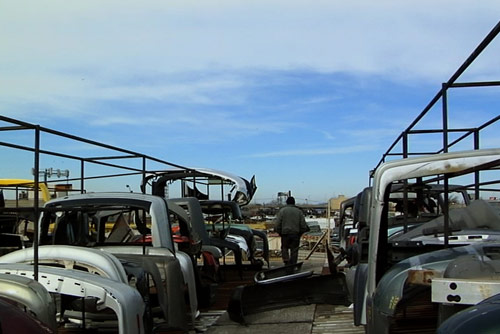
“Foreign Parts,” an 80-minute documentary film co-directed by two fellows at Harvard’s Film Study Center, has already captured six international film prizes. Its first screening in Cambridge is at 7 p.m. April 22 at the Harvard Film Archive. Among those you’ll be introduced to are Luis and Sara, a married couple who live in a van.
Images courtesy of Véréna Paravel and J.P. Sniadecki
A vanishing neighborhood
Film by Harvard fellows creates visual record of scrappy N.Y. district
Willets Point in Queens, N.Y., is a 75-acre patch of hustling junk dealers, mechanics, tire dealers, and auto glass installers. Savvy drivers troll the potholed streets of this offbeat commercial hive looking for the best fix-it deals in New York. About 2,000 people work in 250 businesses.
But the city has plans for a new $3 billion retail and office complex there. Willets Point will soon disappear in a puff of rust, taking with it one of the last vestiges of a scrappy free-market New York.
Luckily, its sights and sounds are captured in “Foreign Parts,” an 80-minute documentary film co-directed by two fellows at Harvard’s Film Study Center. (The fellows program there is the only graduate-level source of arts funding at the University.)
Released last fall, “Foreign Parts” has already captured six international film prizes, including the prize for best first feature at the prestigious Locarno Film Festival in Switzerland. (Its first screening in Cambridge, featuring remarks by both directors, is at 7 p.m. April 22 at the Harvard Film Archive.)
“It was totally surreal for us,” said co-director Véréna Paravel of the Locarno prize, the first in a rapid string of top film festival honors in Italy, Spain, the United States, and elsewhere.
Paravel, a French-born ethnographer, is a postdoctoral associate in Harvard’s Department of Anthropology and in the Sensory Ethnography Lab. Her co-director, J.P. Sniadecki, is a Harvard Ph.D. candidate in anthropology.
Paravel was a novice at making films. Sniadecki had already won film awards, including for “Chaiqian” (“Demotion”), a 2008 documentary on migrant labor in urban China. Now he is a Blakemore Foundation fellow and curator of an independent film series in China called Emergent Visions.
“It’s very interesting how different we are,” said Paravel, who is from the south of France, but grew up in Algeria, Togo, Ivory Coast, Russia, and elsewhere. Sniadecki was raised in Michigan. “But we share this common ground — a small place where we really get each other,” she said. “We speak the same aesthetic language.”
“Foreign Parts” is visually lush and elegiac, an unobtrusive look at the sights, sounds, and people of a vanishing world. The film’s unwitting stars are as obscure and colorful as Willets Point itself. They have names like V.K., Abdul, Chino, Angel, Max, and Moe.

Luis and Sara, a married couple, live in a van. Julia, a bearded homeless woman who favors baseball caps, has been a fixture there for 17 years and calls herself “queen of the junkyard.” Joe, who is 76 and the last legal resident of Willets Point, rages Lear-like at the eminent domain machinery that started to grind in 2008. (Eighty percent of the neighborhood is now in city control.) He roams the pocked and puddled streets like a proud mayor.
Paravel found this little vestige of commerce while living in New York. Tired of writing academic papers and attending conferences, she decided to make a film about city life beneath 12 miles of elevated subway track that starts in Flushing. (The eventual 20-minute film, “7 Queens,” was done for a seminar at Harvard’s Sensory Ethnography Lab.)
But along the way, Paravel discovered the oddity and the energy of nearby Willets Point. She started shooting video in the summer of 2008. Sniadecki joined her that fall, and after two years they had 150 hours of raw footage. “We were the crew,” said Paravel.
The result — edited with panicky speed in Cambridge, China, India, and Paris — was finished just in time for Locarno, thanks to patient help and a sound mix by Sensory Ethnography Lab manager Ernst Karel.
The finished film has no narrative, no contextual interviews, and no political viewpoint, just the views of two observant ethnographers who have a gift for images. A series of 81 vignettes capture the queer vibrancy of Willets Point.
In the first scene, a man with bolt cutters snips hoses in a jacked-up Astro van while fluids gush from the dangling engine. The slaughterhouse imagery remains a cinematic thread. A forklift knifes its blades through a car’s windows and lifts it like a sack. A man saws at a steering column and drags the remnant down the street.
But “Foreign Parts” also lovingly records the accidental beauty of junkyard bricolage. There are walls of hanging side view mirrors, racks of shiny wheels, tunnels of stacked bumpers, and warehouses lined with labeled taillights and wiper motors.
The people seem less ordered. Two Hasidic Jews in broad black hats sit at a desk in a mechanic’s shop, drinking vodka with two other men. One of them says, “The Messiah is coming now,” and raises his glass.
A man with an earring rolls a blunt in a car. Joe pauses during an angry walk to deliver an ornithological aside on the swallows that nest in local trees every May. Sara shows the knife and tire iron she sleeps with while Luis is in jail. She concludes, “So this is how I live.”
One rainy day, Julia dodges street puddles, veering off to hit up old friends for money. (“What am I,” asks one, “an ATM?”) Then she turns to the camera, raising her hands. “This is my people, my friends,” she says.
Last October, Julia had a bottle of whiskey in each pocket when she joined Joe and others at the Lincoln Center for the official U.S. premiere of “Foreign Parts” at the New York Film Festival. Afterward, she told Paravel, “I slept so well.”




